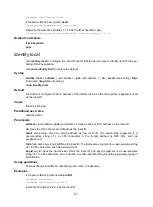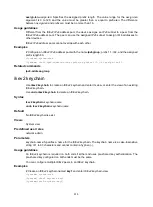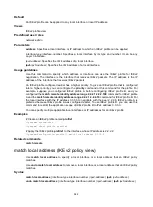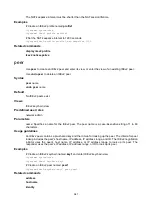
584
Parameters
certificate
policy-name
: Uses the information in the peer's digital certificate as the peer ID for IKEv2
profile matching. The
policy-name
argument specifies a certificate-based access control policy by its
name, a case-insensitive string of 1 to 31 characters.
identity
: Uses the specified information as the peer ID for IKEv2 profile matching. The specified
information is configured on the peer by using the
local-identity
command.
•
address
ipv4-address
[
mask
|
mask-length
]: Uses an IPv4 host address or an IPv4 subnet
address as the peer ID for IKEv2 profile matching. The value range for the
mask-length
argument is 0 to 32.
•
address range
low-ipv4-address high-ipv4-address
: Uses a range of IPv4 addresses as the
peer ID for IKEv2 profile matching. The end address must be higher than the start address.
•
address
ipv6
ipv6-address
[
prefix-length
]: Uses an IPv6 host address or an IPv6 subnet
address as the peer ID for IKEv2 profile matching. The value range for the
prefix-length
argument is 0 to 128.
•
address
ipv6 range
low-ipv6-address high-ipv6-address
: Uses a range of IPv6 addresses as
the peer ID for IKEv2 profile matching. The end address must be higher than the start address.
•
fqdn
fqdn-name
: Uses the peer's FQDN as the peer ID for IKEv2 profile matching. The
fqdn-name
argument is a case-sensitive string of 1 to 255 characters, such as www.test.com.
•
email-string
: Uses peer's email address as the peer ID for IKEv2 profile matching. The
email-string
argument is a case-sensitive string of 1 to 255 characters in the format defined by
RFC 822, such as [email protected].
•
key-id
key-id
: Uses the peer's key ID as the peer ID for IKEv2 profile matching. The
key-id
argument is a case-sensitive string of 1 to 255 characters, and is usually a vendor-specific
string for doing proprietary types of identification.
Usage guidelines
The device compares the received peer ID with the peer IDs configured in local IKEv2 profiles. If a
match is found, it uses the IKEv2 profile with the matching peer ID for IKEv2 negotiation. If you have
configured the
match local address
and
match vrf
commands, the IKEv2 profile must also match
the specified local interface or address and the specified VPN instance.
To make sure only one IKEv2 profile is matched for a peer, do not configure the same peer ID for two
or more IKEv2 profiles. If you configure the same peer ID for two or more IKEv2 profiles, which IKEv2
profile is selected for IKEv2 negotiation is unpredictable.
You can configure an IKEv2 profile to match multiple peer IDs. A peer ID configured earlier has a
higher priority.
Examples
# Create an IKEv2 profile named
profile1
.
<Sysname> system-view
[Sysname] ikev2 profile profile1
# Configure the IKEv2 profile to match the peer ID that is the FQDN name
[Sysname-ikev2-profile-profile1] match remote identity fqdn www.test.com
# Configure the IKEv2 profile to match the peer ID that is the IP address 10.1.1.1.
[Sysname-ikev2-profile-profile1]match remote identity address 10.1.1.1
Related commands
identity local
match local address
match vrf






























